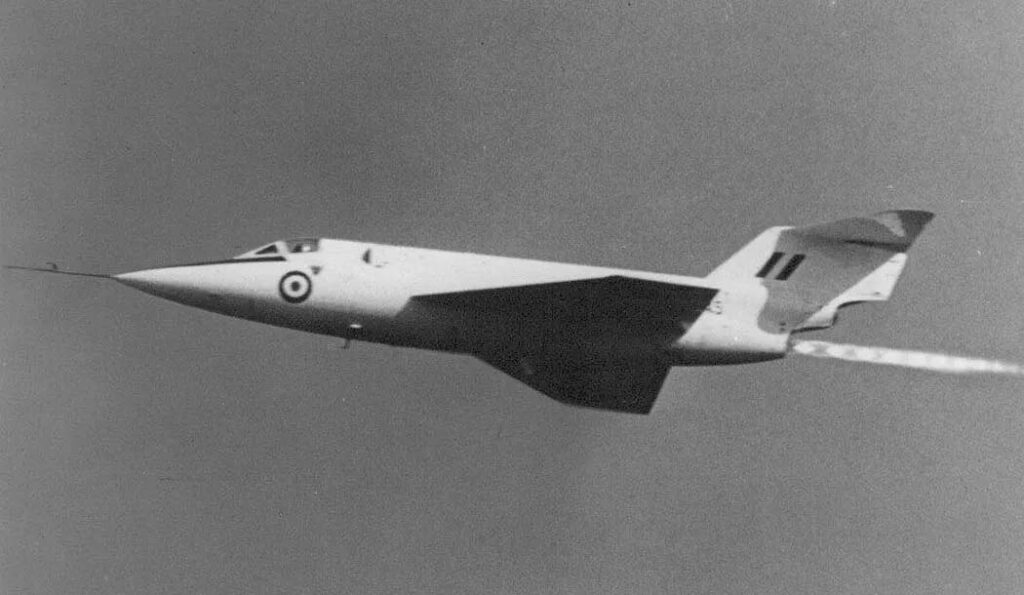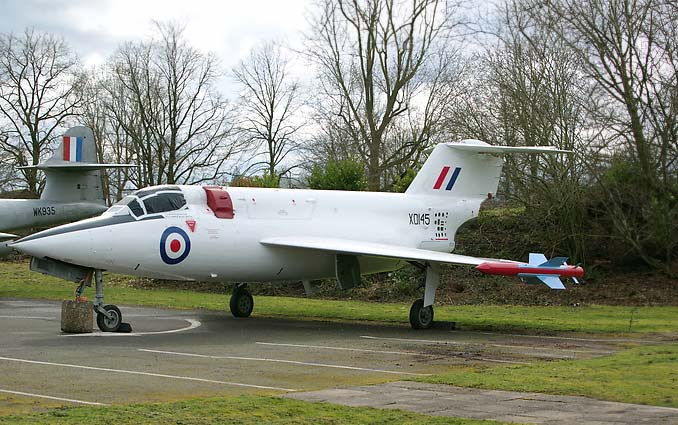British experimental interceptor, Saunders-Roe SR.53, designed for high-altitude, high-speed defense with rocket and jet propulsion.
Technical Summary
The Saunders-Roe SR.53 was an innovative British experimental aircraft from the 1950s, conceived as a high-altitude interceptor capable of rapid response to airborne threats. This aircraft combined rocket and jet propulsion, a novel approach at the time, to achieve remarkable climb rates and operational ceilings. The SR.53 featured a slender fuselage, delta wings, and a unique propulsion system comprising a de Havilland Spectre rocket engine for quick ascent and a Armstrong Siddeley Viper turbojet for cruising and landing. First flown in 1957, it was a testbed for exploring the potential of mixed propulsion systems in intercepting high-speed bombers. Despite its experimental status, the SR.53 contributed valuable data on high-speed flight and interception tactics, although it never entered production or saw combat.
The Saunders-Roe SR.53 emerged in a period of rapid technological advancements and shifting defense priorities. Post-World War II, the threat of high-speed, high-altitude bombers carrying nuclear weapons prompted a reevaluation of air defense strategies. The SR.53 was an answer to this challenge, designed to quickly intercept and neutralize threats before they could reach their targets.

History of the Development of the Saunders-Roe SR.53
The Saunders-Roe SR.53’s development was initiated in the early 1950s, against the backdrop of the Cold War, where the need for effective air defense systems against potential Soviet bomber incursions was paramount. The British Air Ministry issued specification F.124T in response to these threats, seeking a high-performance interceptor that could reach high altitudes at speeds faster than existing aircraft.
Saunders-Roe, a company with a background in innovative maritime and aviation projects, took on the challenge, proposing the SR.53. This aircraft was designed to incorporate a hybrid propulsion system, a revolutionary concept aimed at combining the high-speed ascent capabilities of a rocket engine with the versatility and endurance of a jet engine.
The SR.53 first flew on 16 May 1957, piloted by test pilot John Booth. Its development was closely watched by military and aviation circles, as it promised a new way of thinking about air defense. However, the aircraft did not receive a NATO nickname, reflecting its experimental and unique status within the aviation community.
The context of the SR.53’s development was one of intense innovation and competition, both domestically and internationally. The advent of missile technology and changes in strategic defense thinking eventually overshadowed the project. The SR.53, while a significant technological achievement, arrived at a time when the future of air combat was beginning to pivot away from manned interceptors to missile-based defense systems.
Design of the Saunders-Roe SR.53
The Saunders-Roe SR.53 was an embodiment of cutting-edge design and technology. Its slender fuselage was optimized for high-speed flight, while its delta wings facilitated the high-altitude performance required of interceptors during the era. The aircraft measured approximately 46 feet in length (14 meters) and had a wingspan of 25 feet (7.62 meters), dimensions that contributed to its agility and performance.
The heart of the SR.53’s design was its propulsion system. It featured a de Havilland Spectre rocket engine capable of producing a thrust of 8,000 pounds-force (35.6 kN) for rapid climbs and a Armstrong Siddeley Viper turbojet engine with a thrust of 1,640 pounds-force (7.3 kN) for cruising and landing phases. This combination allowed the aircraft to quickly ascend to intercept targets and then return to base using the more fuel-efficient turbojet engine.
One of the main advantages of the SR.53’s design was its rapid response capability, enabling it to reach interception points faster than conventional jet-powered aircraft. However, the reliance on rocket propulsion also introduced drawbacks, such as limited endurance at high speeds and the logistical challenges of handling and storing rocket fuel.
Despite these challenges, the SR.53 brought significant insights into the integration of mixed propulsion systems in military aircraft, highlighting the potential and limitations of such configurations for future designs.
Performance of the Saunders-Roe SR.53
The performance of the Saunders-Roe SR.53 was a testament to the potential of hybrid propulsion systems in military aviation. The aircraft could achieve a top speed of over Mach 2 at high altitudes, with the rocket engine enabling a climb rate that was unmatched by purely jet-powered contemporaries. Its operational ceiling exceeded 70,000 feet (21,336 meters), placing it well above the cruising altitudes of the bombers it was designed to intercept.
The SR.53’s range and endurance were constrained by its propulsion system, particularly the rocket engine’s fuel consumption. This limitation meant that while the aircraft could quickly reach its operational altitude and speed, it could only maintain these conditions for a short duration before needing to return to base.
When compared to its contemporaries, such as the English Electric Lightning, the SR.53 offered a different approach to the interception challenge. While the Lightning became a mainstay of the Royal Air Force’s interceptor force, the SR.53’s experimental nature and its focus on high-speed, high-altitude interception provided valuable data that would influence future aircraft development, despite its own operational limitations.
Variants of the Saunders-Roe SR.53
The Saunders-Roe SR.53 program produced two main variants: the initial prototype, designated XD145, and a second prototype, XD151. These variants were primarily distinguished by minor design modifications and equipment updates intended to improve performance and facilitate testing. The second prototype, XD151, featured enhancements based on flight data and experiences from the testing of XD145, aimed at optimizing the aircraft’s aerodynamics and propulsion system efficiency.
Despite the limited number of variants, the SR.53’s development program was crucial in advancing the understanding of hybrid propulsion systems and high-speed flight characteristics. Although further variants or production models were not developed, the knowledge gained from the SR.53’s testing contributed to subsequent aerospace projects and research.

Military Use and Combat of the Saunders-Roe SR.53
The Saunders-Roe SR.53 was designed as a high-altitude interceptor, but it never saw military use or combat. Its development was primarily for research and experimentation, focusing on the potential of mixed propulsion systems for rapid interception roles. The SR.53 was armed with two Firestreak air-to-air missiles in proposed operational configurations, reflecting its intended role as a defender against high-altitude bombers. However, as the project progressed, shifts in military strategy and the emergence of surface-to-air missiles as primary defensive tools led to a reevaluation of the need for such aircraft.
The SR.53 did not compete directly with other aircraft in operational scenarios, as its development coincided with a transitional period in air defense philosophy. While it provided invaluable data on high-speed, high-altitude interception, the advent of missile technology and changing defense priorities meant that the SR.53 remained a unique and experimental project, without transitioning to active service or export to other countries.
The termination of the SR.53 program and the shift towards missile-based air defense marked the end of this innovative aircraft’s potential military career. It was not replaced by another aircraft but rather by a new generation of defense technologies that emphasized unmanned systems and ground-based interceptors.
The Saunders-Roe SR.53 stands as a remarkable example of innovation and experimentation in the field of military aviation. Its development during a period of significant technological and strategic transition provided valuable insights into the capabilities and limitations of mixed propulsion systems for high-speed, high-altitude interception roles. Although the SR.53 never entered production or saw combat, its legacy endures in the lessons learned and the technological advancements it contributed to the aerospace community. The SR.53’s exploration of hybrid propulsion, rapid climb rates, and operational ceilings pushed the boundaries of what was possible, influencing future aircraft design and defense strategies. In the annals of experimental aircraft, the Saunders-Roe SR.53 remains a symbol of the pursuit of speed and altitude in the service of air defense.
Back to the experimental aircraft section.